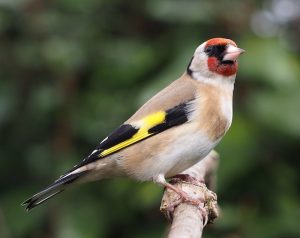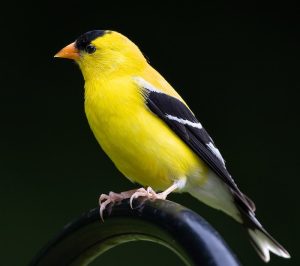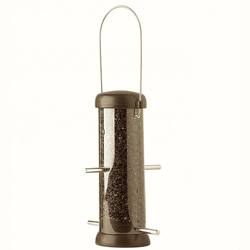Guest Blogger Fatbirder
If you love watching birds, you will want to attract goldfinches to your backyard feeders. Whether they are the beautiful yellow and black songbirds that are common in many parts of North America or charming European goldfinches which are found across most of Europe and beyond, with their yellow wing flashes and red faces. Both can add a splash of colour to your garden. Here are some tips on how to attract goldfinches to your feeders. Oddly, this holds for both species which have very similar feeding habits despite being separated by thousands of miles of ocean.
Offer thistle seed: Goldfinches love thistle seed, so offering this type of seed in a specialized thistle feeder is one of the best ways to attract them. These feeders have small ports that dispense the seeds, and their design prevents other birds from stealing the food as the beaks of most finches are too large to winkle out the tiny black seeds.. In Asia and Europe this is known as Nijer, or Nyger seed, although there is no agreement on the spelling!

European Goldfinch Carduelis carduelis
Provide a variety of feeders: While thistle feeders are the best way to attract goldfinches, they also enjoy other types of seeds and feeders. Adding a tube feeder with sunflower hearts or a hopper feeder with mixed seeds may not initially attract them to your yard, but once they smell the nyjer they will come in and probably quickly shift their allegiance to sunflower hearts or suet as they offer even better nutritional value. Fat balls, peanut butter (only the sort designed for birds with no additives), meal worms and all will also be eaten, if the goldfinches get a look in when feisty starlings or grackles are about.
Use bright colours: North American Goldfinches are attracted to bright colours, so adding some yellow to your feeders or nearby flowers can catch their attention. You can also add a yellow or bright-coloured feeder to your yard to help attract them. In the UK blue tits and great tits became habituated to the colour red because peanuts for birds were often sold in red plastic mesh tubes you could hand up for them. In North America nectar feeders put out for hummingbirds are most often red and yellow to ape the colours of the flowers they naturally feed upon.

American Goldfinch Spinus tristis
Place feeders in a sheltered area: Like most passerines, goldfinches prefer to feed in areas that are sheltered from the wind and rain. Placing your feeders in a protected area, such as under a tree or on a covered porch, can make them more inviting to the birds. However, a word of warning, you need to strike a happy balance between shelter and safety, birds need to see predators when they are coming. There always needs to be an escape route into as dense bush or the open sky.
Offer water: Goldfinches like most birds that turn up in yards and gardens need water for drinking and bathing, so providing a bird bath or small water feature nearby can make your yard more attractive to them. In cold weather remember to ensure ice is removed and that birds can still find drinking water. In deep water features always provide a branch or other way for birds and other animals to climb out if they fall in.
Be patient: Goldfinches on both sides of the Atlantic can be a bit finicky and may take some time to discover your feeders. It may take weeks before you start seeing them at your feeders, so be patient and keep your feeders filled. Eventually, they will smell the nyger and once they find it they will keep coming back. I haven’t had nyjer in my tiny yard for years and years, but the goldfinches are still regular because they know I put out all sorts of food, especially in the winter months.
By following these tips, you can increase your chances of attracting goldfinches to your backyard feeders. Watching these beautiful birds can be a rewarding and enjoyable experience for birdwatchers of all ages. All of us bird lovers want to make sure the next generation grows to love birds and the more colourful they are the more noticeable to kids.
